Lipari is the largest and most populated of the Aeolian Islands (Isole Eolie or Isole Lipari in Italian), a volcanic archipelago off the coast of Sicily. The island has the biggest town of the archipelago, also called Lipari; a lively busy place with picturesque streets, an attractive harbour and a historic castle-citadel. Like its island neighbours, Lipari has volcanic origins. The last eruption on the island took place around 1,400 years ago, and there are currently no signs of volcanic activity other than thermal springs and fumaroles. The island’s geology is the most visible reminder of Lipari’s origins; until recently one of its main industries was extraction of pumice, created by past eruptions. The island’s population is around 10,000.
Lipari is the most practical base for visiting the Aeolian Islands. Fast ferry connections from Sicily all stop here, and there are plenty of boats and hydrofoils to the other islands. Outside the main Italian tourist season (late July – August) Lipari town is large enough not to feel overwhelmed by tourism. It also has a good choice of accommodation for different budgets, a supermarket, bars, restaurants, shops and other services. When I toured the islands I stayed here, and loved the Italian small-town feel and island atmosphere.
You can easily spend a day pottering around Lipari and touring the museum, with a leisurely lunch and an afternoon drink by the harbour. If you have longer, you could make the interesting and scenic journey around the island on its principal circular road, with breaks at viewpoints and ruins (see below). Lipari’s second town, Canneto, is not particularly interesting, but you can stroll along the seafront and sunbathe, swim or boat from its long pebble beach (there is a better beach, with sand, just past Canneto). When the temperature isn’t too hot, walking is a good activity on the Aeolian islands, and there is a panoramic headland walk possible from Lipari town, which I’ve described below.
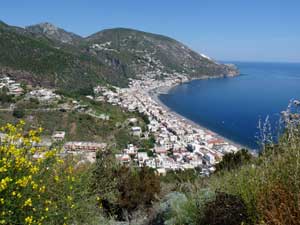
Lipari’s history
Lipari has a very long and distinguished history. The Aeolian Islands have a place in mythology, and certainly they were inhabited as far back as 5,000 BC. The ruins of Bronze Age settlements can be visited on Filicudi and Panarea. Lipari’s position has always made it important for maritime trade, and the island has a rare and valuable resource: black volcanic obsidian, used for knives and sharp implements. The natural harbour of Lipari town is dominated by a convenient rock outcrop, and this was the obvious place for early settlers to build their homes and fortifications. Walking up to the town’s citadel now, visitors can see excavations revealing many levels of history.
When Sicily and southern Italy were colonised by Ancient Greeks, Lipari was an important and well-off town, as is demonstrated by the extensive necropoli and high quality of grave goods found on the island, many examples of which can be seen in the town museum.
Over the centuries Lipari was besieged, conquered and taken over many times, by Carthaginians, Romans, Saracens, Normans, Spanish and finally by a united Italy. The worst attack on record was that by the Turkish corsair Barbarossa, who savaged the island in the sixteenth century, and transported almost the entire population into slavery. Afterwards, Lipari was re-settled by the Spanish rulers of Sicily, who built new fortifications on top of the Greek acropolis. In recent centuries, like the other Aeolian Islands, Lipari’s fortunes have gone up and down. Some of the population emigrated to the New World, but as tourism began playing a larger role, the islands’ star has risen. As well as being a popular holiday destination for Italians, the volcanoes of the Aeolian Islands attract adventure-seekers from around the world, and Lipari profits from being the best base for an island-hopping holiday.
Lipari had until recently a sideline in pumice extraction. However, this eats away at the island and scars the landscape. Not long before my visit, UNESCO had issued an ultimatum, warning the Aeolian Islands that they must make improvements in order to retain their precious UNESCO World Heritage listing, with particular reference to this destructive industry, and by the time I arrived the cranky old machinery by the pumice workings stood still and abandoned, the loading pier damaged by winter storms and unrepaired. Small pieces of pumice stone are sold by souvenir shops and enterprising local children. There are also places on the hillside where you can gather your own pumice; an unusual (and unusually useful) holiday souvenir.
The Aeolian Islands’ patron saint is San Bartolo (Bartolomeo, Bartholomew), whose remains are claimed to have washed up miraculously on Lipari’s shore in 264 AD. The relics of the saint are now elsewhere (Canterbury Cathedral apparently has one of his arms), but Lipari retains a holy thumb. His feast day, the 24th August, is a massive celebration on Lipari, with festivities and fireworks.
Lipari town
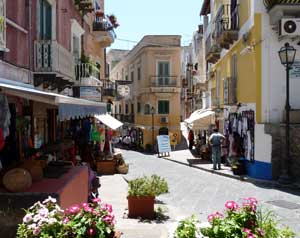
Lipari town is a very pleasant place, with pretty streets and lanes perfect for wandering around. There are some elegant historic town-houses as well as plenty of more humble island-dwellings, with balconies bedecked with flowers, washing, onions and peppers. The town has a very cheery atmosphere, and although tourists must get used to touts offering boat trips, the local people in Lipari are all very friendly and welcoming. There are a lot of appealing shops selling souvenirs and good-quality local food and drink; including huge quantities of the local capers and Malvasia wine – both very good items to take home, if your luggage will allow it.
If you explore the streets of Lipari, you will soon come across traces of the island’s ancient history. Greek tombs lie open to the sky in parkland (generally closed but visible through fences). But the most impressive historic site in Lipari is the castello, the castle. This fortified headland is more than a castle; it is a citadel and the heart of the town was once here. The traditional entrance route is through a defensive gateway, but there is also an additional direct stairway piercing the fortress walls. This is because, when the hub of the town shifted down to the lower streets, there was talk of switching the town’s cathedral to a different church. Rather than have this happen, the authorities cut through the castle walls to provide easy direct access to the cathedral from the main part of town. A stroll through the citadel is a must for visitors to Lipari; those with an interest in the past will also wish to visit the museum, housed in several buildings within the castle walls.
Lipari’s important archaeological museum is called the Museo Archeologico Regionale Eoliano “Luigi Bernabò Brea” (9am-1pm, 3pm-6pm, closed Sunday and holiday afternoons. Entrance 6) and contains finds from all over the Aeolian Islands. The collections are very fine, from ranks of assembled amphorae salvaged from wrecks, to high-quality Greek vases. The museum is particularly renowned for its hoard of models of Greek theatrical masks, mostly found in tombs on the island.
The cathedral, one of several churches within the fortified complex, has ancient origins but after several re-buildings isn’t particularly striking. However, it is worth paying for admission to the rediscovered twelfth-century Norman cloister (chiostro Normanno), a wonderful little space with some appealing column capitals depicting animals.
The best illustration of Lipari’s long history is an excavated area inside the citadel, where the curious passer-by can see the remains of different layers of habitation, from Neolithic times onwards. A shady corner of the outcrop is covered with rows of Greek and Roman tombs, and overlooking the pretty harbour is a modern version of a Greek open-air theatre (built in the twentieth century), where plays and other entertainments are held. From various points of the castle there are great views over Lipari and the Mediterranean.
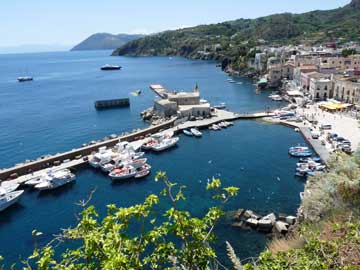
Lipari has two harbours, situated on either side of the castle headland. To the north is Marina Lunga, a functional port where both large ferries and fast hydrofoils dock. At the time of writing there is talk of shifting hydrofoil services back to their original port, but until this is done, Marina Lunga will be the arrival point for most passengers visiting Lipari. There’s a ticket office with desks for both the principal ferry companies, Siremar and Ustica Lines, by the jetty. Marina Corta, to the south of the citadel, is a much more charming historic harbour, colourful with fishing boats. This was the former drop-off point for hydrofoils; when I visited Lipari I was told that plans to extend this harbour had been held up by underwater archaeological finds. The harbour is a wonderfully picturesque spot, with children splashing in the water, fishermen playing cards in the piazza, a lazy stray dog dozing, and the sun illuminating a little church out on the jetty. The atmosphere was very peaceful – but this was a sore point with the owners of nearby cafes and restaurants, who had lost a lot of trade with the relocation of the passenger services. If you are spending time on Lipari, whichever port you disembark at, you’ll be likely to find yourself whiling away pleasant island hours down by the water at Marina Corta.
Lipari’s main street is Corso Vittorio Emanuele, a lively little road which runs from Marina Lunga along the back of the castle headland. Along the Corso you’ll find most of the island’s useful shops and services: a tourist information office; a small supermarket; a bookshop; clothes boutiques; cafe-bars; restaurants; souvenir shops; speciality food stores. Other small streets and alleys head off Corso Vittorio Emanuele, connecting it with the castle and with Marina Corta. The Necropolis Diana, where many of the archaeological finds were uncovered, is just behind the centre.
Island transport
You can find information on reaching the Aeolian Islands on my Aeolian Islands homepage. Since Lipari is the most populated island, it has very frequent ferry and hydrofoil connections with Milazzo in Sicily as well as services to other Sicily and mainland Italy ports. The website of the Comune di Lipari (district council) contains useful timetables, including lists of arrivals and departures for Lipari. I found that hotels were also good source of information on ferries, timetables and weather conditions.
You can easily walk through Lipari town from the port, although some hotels will come and pick you up. For seeing more of the island, there are convenient little buses which run along the island’s few roads. One bus heads to the south of the island, and one to the north. More usefully, in summer there is a service which does a full circuit of Lipari. There is a bus information and ticket kiosk by Marina Lunga, where ferries dock. There are also plenty of taxis stationed by the waterfront, offering lifts or island tours, and you can hire cars, scooters and bicycles.
Touring the island
I took a taxi trip around the island, for 50. Drivers with comfortable modern taxis, some seating six or more, hang around by the ferry port, offering lifts and tours. A standard tour around the island (giro dell’isola) follows the principal road which circles the island, stopping at viewpoints. If you’re interested in history, negotiate a detour to the Terme di San Calogero. This is an absolutely fascinating spot, described below. Taking a taxi was a very comfortable and convenient way of seeing the island, and if you are in a small group, it’s not too expensive. As well as taking me to the archaeological site, my friendly driver stopped at viewpoints where little stalls offered free samples of local products, took a photo for me, told me about the island, and stopped by a spoil heap where I was able to hunt for pieces of obsidian and pumice to take home as souvenirs. These experiences were among the highlights of my stay on Lipari, so well worth the expense.
It is also possible to see the island by bus, but this is obviously a less flexible and personalised option. If you have plenty of time on Lipari, however, you may wish to explore more of the island independently, combining bus travel and walking. One of the best viewpoints, reachable by bus, is Quattrocchi (‘four eyes’) – there are various stories about the name, the most popular being that you would need four eyes to take in the superb view over Lipari and Vulcano.
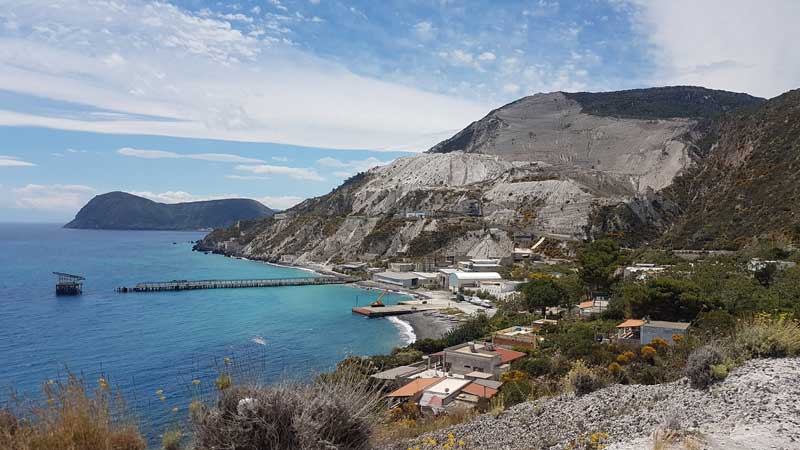
Terme di San Calogero
The Terme di San Calogero are thermal springs on Lipari which have been used for thermal baths for thousands of years. Archaeologists think that some of the structures around the springs date back to the Myceneans. Shamefully, the site has been used for typically southern Italian ‘developments’ – a large spa/holiday establishment stands alongside, which at the time of my visit had no definite plans for opening, and the important archaeological site was closed off to the public and seemingly left in abandonment. However – and equally typically – the wall alongside the springs was a convenient height for climbing over, and this indeed is what determined tourists and spa-seeking locals do. An elderly man waited alongside the site, to provide an unofficial ‘tour guide’ service – his English was garbled, but he deserved a generous tip for his resourcefulness, I felt. In an igloo-shaped stone structure, hot springs rise to create a kind of sauna, with a stone bench around the walls. Outside, the hot water runs into a rectangular pool, constructed with square-cut stones; the Roman bath, according to my guide. It was a terrible shame that these monuments weren’t better-cared for, better investigated and officially opened to the public with full historical information. Hopefully this situation will improve, and it is worth asking about access when you visit Lipari. However, my illicit visit to the ruins was certainly an archaeological adventure, and very memorable.
Excursions and boat trips
There are lots of boat trips from Lipari which visit the other Aeolian Islands. During the summer you’re spoiled for choice; outside the peak season you may still find some excursions operating. Walking around Lipari town you’re assailed on all sides by advertisements and salespeople for boat trips; they’re all very similar and comparably priced. All of the islands are worth visiting, but the most popular excursion is to Stromboli. To visit the active volcano, you can take an early-morning trip to climb the volcano, or an later trip which also visits Panarea, and leaves Stromboli after dark, in order to watch the eruptions from the sea. This is a long but exciting outing, and I’d recommend it.
All year round, sea conditions permitting, there are ferry connections between the islands, so if you’d rather travel independently instead of taking a boat excursion, this is a manageable alternative. You should check timetables in advance to plan your outing. Although independent excursions mean you’re not restricted to the brief stopovers of an organised trip, bear in mind that you’re not likely to get such good close-up views of the shore, and may miss out on some of the sights toured by smaller boats.
A walk from Lipari
To the north of Lipari town, blocking its view of the other islands, is a large, rounded headland which is a tempting destination for walks. It is called Monte Rosa and offers good views of Canneto to the north and Lipari town to the south. Do be warned that its scale is deceptive; the walk is longer and with more uphills than you might think – I’d allow two to three hours to walk there and back. Take sun protection and water to drink.
The route is easy – just follow the coastal road towards the headland from Marina Lunga. The road passes underneath the headland through a tunnel; before the entrance take a lane turning off inland. This climbs and bends around towards the headland, passing scattered houses. By the final houses a footpath leads off to the left; this continues around the slopes, dipping then rising again to reach a chapel just below the summit of the headland.
I did this walk quite comfortably wearing summer clothes and flip-flops, overtaking a party of toiling Germans in full hiking gear. But do take water, sun protection and a map – and I’d recommend more substantial footwear than I chose. The German group were accompanied by a dishevelled looking dog – when we chatted they explained he had simply attached himself to them in Lipari and come along for the walk.
Food and drink
Lipari is full of pleasant places to eat and drink. These are mostly touristy, but (since many tourists are Italians and thus food conoisseurs) of a decent standard and fairly reasonably priced. The most scenic place to eat is Al Pirata, at Marina Corta, where the tables are on a terrace by the sea. I ate several times at A Sfiziusa, a little way up Via Roma, where the food was filling and very good value.
For a pleasant and refreshing afternoon or evening drink, the best bars are clustered around the centre of Corso Vittorio Emanuele, where the Eden Bar is the heart of the town’s evening passeggiata, with more options down by Marina Corta, where you can sit overlooking the bobbing boats in the harbour. After the afternoon siesta, when Lipari’s streets are deserted other than by a few hot tourists, the evening is when the town really comes to life, as everyone takes to the streets for a stroll and a chat or, in summer, for livelier late-night entertainments. Sitting outside a grotto-like bar by the harbour in the evening was like stepping back in time to a 1950s film. Boats bobbed on the inky water, a musician played and couples danced indoors, the red wine flowed. After a passeggiata along the Corso, and a drink with snacks at the Bar Eden, the picturesque harbour at Marina Corta is the place to come and sit for a romantic island evening.
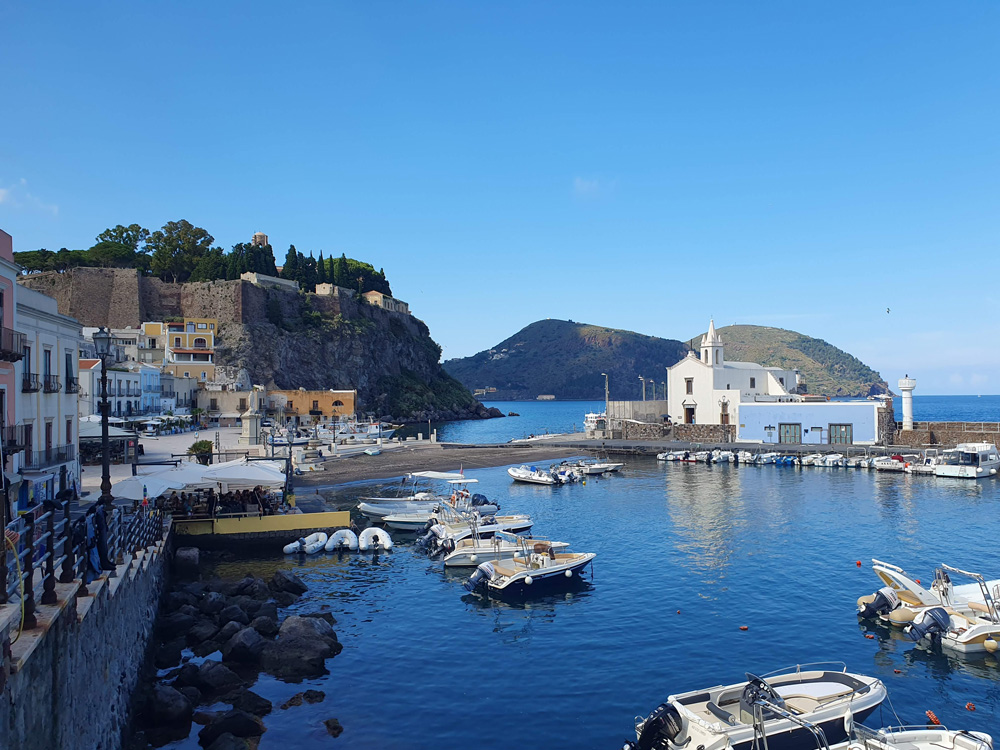
A top destination
For its combination of charm, scenery, history, practicality and holiday atmosphere, Lipari would be very hard to beat. On my first visit I booked for four nights, and loved it so much on Lipari that I changed my flight to allow for more time and more boat trips to other islands. I wrote the notes for this page sitting by the little harbour in Lipari town with a glass of the sweet local wine Malvasia – served with biscotti – while the little chapel beyond the fishing boats glowed in the evening sun and local children played football. Lipari is a stop for cruise ships, and for day trips from Italy and Sicily. But ideally these islands really are places to come for a longer stay, to sightsee and unwind in lovely, unique surroundings. The hardest thing is leaving.
Accommodation
Lipari has a lot of accommodation options, though for the widest choice I’d recommend booking months in advance. There are hotels ranging from modern and well-equipped to basic and cheap. Summer visitors often choose to rent rooms or apartments for an independent stay, and again there’s a good choice of these, along with B&Bs.
I always stay in Lipari town or within walking distance, in order to benefit from the transport connections and lively town atmosphere. But if you would enjoy a relaxing stay without too much travel, it’s worth considering staying in one of the villages or beach resorts where you might find cheaper prices and a sense of getting away from it all.
Residence Alberghiero Eolie
I’ve stayed several times in this excellent residence on Corso Vittorio. It couldn’t be more central, and has excellent accommodation, offering large rooms with kitchen corners – the top floor rooms have terraces, too. The residence also has a communal roof terrace.
> Read my hotel review
> More information / make a booking
Hotel Oriente
I’ve also stayed, some years ago, at the Hotel Oriente. This good-value hotel is nearly as central as the Residence, and is a decent place to stay, with shady garden rooms and (when I visited) fascinating displays of local curios that made it feel like a folkore museum.
> More information / make a booking
> Search availability for more Aeolian Islands hotels
On this site
South to Calabria: a travel itinerary finishing in the Aeolian Islands
Hotels in Italy – what to expect
Useful external links
Air Panarea (helicopter connections)
Ferries
